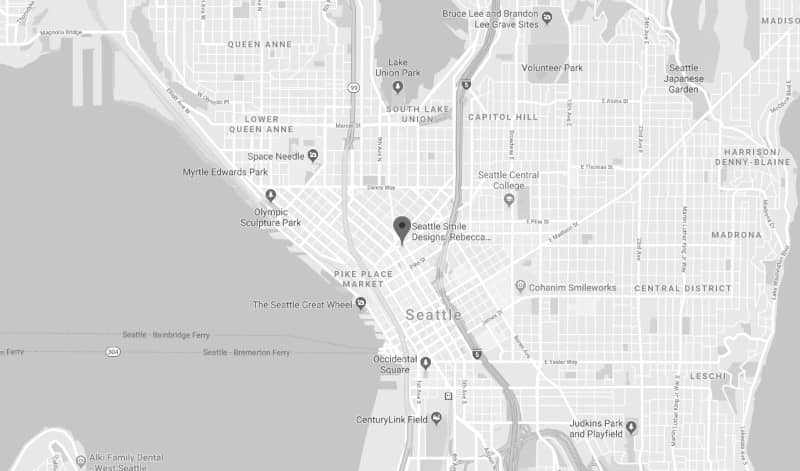Formerly Seattle Smile Designs & Bellevue Center for Orthodontics
Refer a PatientPatient FAQ
We Are
Here To
Help
Frequently
Asked Questions
What do orthodontists do?
Orthodontists are dental specialists who diagnose and treat problems with the position, alignment or spacing of the teeth, and related irregularities in the face and the jaw. We use a number of special treatments, including braces and other oral appliances, to correct these problems.
Why should I (or my loved ones) get orthodontic treatment?
There are two good reasons: aesthetics and function. Having an attractive smile not only changes the way people see you — it enhances your own self-image as well. Orthodontic treatment also allows your teeth to function better and makes it easier to keep them clean, which can improve your overall health.
When should orthodontic treatment be started?
You are never too old to begin orthodontic treatment — but if you start at an earlier age, your problems may be easier to treat. The American Association of Orthodontists recommends that a child who may need orthodontic treatment should come in for a first visit around age 7. If you notice a growth or dental pattern you are concerned about, please come see us prior to age 7 for a consultation.
How can I recognize a potential bite problem?
Teeth that are protruding, crowded together or erupting out of position are clear indications that treatment is needed (View Examples). Less obvious signs are mouth breathing, frequent biting of the cheek or palate, speech difficulties, and thumb sucking that goes past 3-4 years of age. If teeth don’t meet properly when the mouth closes, or if jaws make sounds or shift as they move, this may also indicate an orthodontic problem.
Does getting braces hurt? What about wearing them?
Having braces put on is generally painless. Some people experience minor aches and pains in the first couple of days or so, as they adjust to wearing their appliances; periodic adjustments may sometimes cause soreness as well, though it typically lasts only a short time. Over-the-counter pain relievers can be used to alleviate any discomfort but are usually unnecessary.
How long will treatment take?
It’s different for each person, but generally the active stage of treatment (that is, wearing braces or other appliances) may take from 6-30 months. After that, a retainer is worn to maintain the teeth in their corrected position.
How often will I come in for an appointment?
It depends on what’s being done, and how often you need to be monitored. During active treatment, you’ll typically come into our office once every 4 to 10 weeks.
Will I need to have any teeth extracted?
If your teeth are severely crowded (because your mouth is too small to properly accommodate all of them) — or if you have impacted teeth (teeth that are trapped beneath the gum line by other teeth) — then extraction may be necessary. In the case of younger patients, early intervention may make extractions unnecessary.
Will I have to watch what I eat?
Yes — you should pass up the types of foods that could damage or become trapped in your braces. Some of these include raw vegetables, hard candy, caramel, taffy and ice cubes (fortunately, ice cream is OK). We will give you a list of foods to avoid.
Will I be able to play sports/ play my instrument?
Yes. Of course, whether you wear braces or not, we recommend you wear a mouthguard when playing most sports. Musicians are generally able to play their instruments just as they did before, but they may need a short adjustment period after getting braces glued to the teeth.
Do I still need to see my regular dentist while I’m getting orthodontic treatment?
You do — in fact, it is more important than ever! Keeping teeth free of plaque (and potentially, decay) can be challenging when you are wearing braces. Your dentist can help you avoid these problems with frequent cleanings and exams.
Will I wear a retainer when my braces come off?
Almost always, the answer is yes: If you do not wear a retainer, your teeth can rapidly shift out of position — and then all the effort put into your treatment is lost! Your retainer helps you maintain your beautiful smile for a lifetime.
Is orthodontic care very expensive?
Orthodontic care is a long-term investment in your health and well-being. The cost of orthodontic treatment has not increased as fast as many other consumer prices, and many financing options are available that make orthodontic care affordable. Weighed against the true cost of living with problem teeth, however, orthodontic treatment can be a wise and prudent investment.
Financial
Information

Orthodontic benefits are separate from dental benefits. Even though you may be covered by dental insurance, you may or may not have orthodontic coverage.
---Familiarizing yourself with the details of your coverage may avoid misunderstandings later. Please give our staff your insurance information when you schedule your initial appointment. As a courtesy to you, prior to your appointment, our office will contact your insurance carrier to confirm what insurance benefits are available to you. Please note that these benefits may change if you change jobs or change insurance coverage while undergoing treatment.
Eligibility
The requirements for benefits eligibility vary by policy. Some policies require a waiting period for new employees, while others may require a specific number of hours to be worked per pay period to remain eligible. Orthodontic coverage in some cases is available only to dependent children under the age of 19. If you are unsure of eligibility requirements, you should refer to the plan booklet or contact the insurance administrator at your place of business.
How Benefits are Calculated and Paid
There is no universal formula for calculating the amount to be paid toward the initial appliance placement fee or subsequent monthly fees. Each policy maintains its own formula. If you change insurance providers or change jobs while in treatment, you may not receive the entire anticipated insurance benefit. It is common for orthodontic benefits to be paid at 50% of the treatment fee to a lifetime maximum amount. Your policy may have a yearly deductible.
Flexible Benefits Plans & Executive Management Plans
Flexible Benefit Plans have become a very popular method of projecting “before tax” dollars to be spent during the next plan year. These types of plans commonly allow the insured to allocate a specified number of salary dollars toward certain expenses, usually medical, dental or child care expenses. Because these dollars are not subject to payroll taxes, they are a very attractive way of increasing the value of your “insurance dollars.” In most cases, there are very specific rules about when orthodontic treatment is initiated to receive the greatest benefit. You must declare the amount to be spent for the year prior to the beginning of the plan year. The plan year for the policy may or may not be a calendar year. You stand to receive the greatest benefit by planning how orthodontic treatment can fit into the rules of your Flexible Benefit plan. You may wish to confirm the beginning of your flexible benefits plan year.
What if I Have Multiple Coverage
If the patient is covered by more than one orthodontic insurance policy, the carriers will determine which plan is considered the primary policy. Often this determination is made by birthdates of the insured parties. This method of determination is not a universal formula, but is individual to each carrier. The secondary insurance carrier will not declare or pay benefits until the primary carrier has made a determination of treatment that will be covered. The secondary carrier usually requires written confirmation from the primary carrier of the benefits to be covered.
How Our Orthodontic Offices in Bellevue and Seattle Can Help
Insurance benefits are coordinated between the insurance carrier and the insured. To assist you, we will gladly submit insurance claims and we accept most insurance benefit assignments.
Our goal is a beautiful smile at two locations

Seattle Orthodontics
---509 Olive Way Suite 840
Seattle, WA 98101
Text or Call: (206) 623-2192 | Email
Office Hours
Mon - Wed, 8:00 AM - 4:30 PM
Thu, 9:00 AM - 12:00 PM

Bellevue Orthodontics
---1200 112th Ave NE B-200
Bellevue, WA 98004
Text or Call: (425) 453-0551 | Email
Office Hours
Mon - Thurs, 8:00 AM - 4:30 PM
Fri, 9:00 AM - 4:30 PM